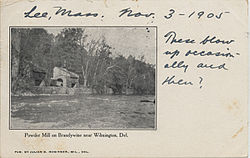Eleutherian Mills
|
Eleutherian Mills
|
|

Working powder mills on Brandywine Creek, about 1905. Note the handwritten "These blow up occasionally, and then?"
|
|
| Location | North of Wilmington on Delaware Route 141 at Brandywine Creek Bridge, near Wilmington, Delaware |
|---|---|
| Coordinates | 39°46′50″N 75°34′30″W / 39.78056°N 75.57500°WCoordinates: 39°46′50″N 75°34′30″W / 39.78056°N 75.57500°W |
| Area | 191.2 acres (77.4 ha) |
| Built | 1803 |
| NRHP Reference # | 66000259 |
| Significant dates | |
| Added to NRHP | November 13, 1966 |
| Designated NHL | November 13, 1966 |
From 1802 to 1921, Eleutherian Mills was a gunpowder mill site used for the manufacture of explosives by the Du Pont family business. The name also refers to the house on the hill above the mills, which was the first Du Pont family home in America. The business was founded by Eleuthère Irénée du Pont. In 1952, the site became an outdoor museum and the Hagley Museum and Library was founded.
Jacob Broom built a cotton mill on the site in 1795. The mill burned down in 1797 and in 1802 he sold the site, complete with a working dam and millrace to Eleuthère Irénée du Pont, who paid $6,740 for the 95 acres (380,000 m2).
The first domestic supplies of high-quality gunpowder were made in the US by E. I. du Pont de Nemours and Company. The company was founded in 1802 by E.I. du Pont, two years after he and his family left France to escape the French Revolution.
They set up the Eleutherian gunpowder mill on the Brandywine Creek just north of Wilmington, Delaware, based on gunpowder machinery bought from France and site plans for a gunpowder mill supplied by the French Government. They also built housing for 30 workers.
Starting, initially, by reworking damaged gunpowder and refining saltpetre for the US Government they quickly moved into gunpowder manufacture.
Saltpetre was refined in an area between the house and the mills that now is occupied by a formal garden. Charcoal was produced from the willow trees that lined the Brandywine.
By the end of 1804, DuPont had sold 39,000 pounds of powder; the following year sales tripled. The Federal government and John Jacob Astor's American Fur Company became regular customers. In 1813 the Hagley property, just downstream from the original mills, was purchased, doubling the size and capacity of the mills. Sales grew during the Mexican-American War and the Crimean War. During the American Civil War, the firm sold 4,000,000 barrels of powder to the Federal government.
...
Wikipedia


